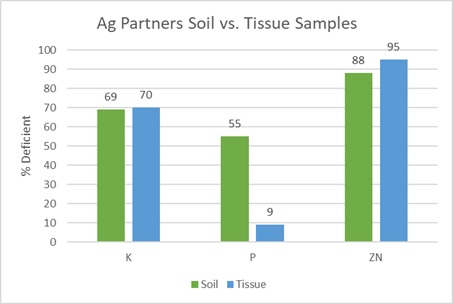by Mike Alme MikeA@agpartners.net
Our Ag Partners AYS program provides valuable local data. A strong plant nutrition program starts with identifying your plants’ needs early in the season and continuing with “check-ups” throughout key growth stages. Tissue sampling allows us to pinpoint exactly what’s going on in a plant, so real-time nutrient adjustments can be made to optimize yield potential. Many growers across Ag Partners service area have utilized the Nutrisolutions® tissue sampling program in the past to allow them to be their plant’s personal dietitian.
Analysis helps farmers make in-season fertility adjustments to optimize yield potential
Farmers in Minnesota who conducted on-farm tissue sampling with WinField United® to evaluate crop health last season were better-equipped to make informed fertilization decisions. Tissue sampling is just part of the program, which also includes soil testing, predictive analysis, product recommendations, and expertise to help guide production practices for high-yielding crops.
Why should I tissue sample my fields?
- Tissue sampling provides a way to verify how much fertility is making it into your plants.
- Tissue sampling identifies limiting factors, so farmers can decide IN SEASON whether the crop will benefit by addressing it.
- The ability to make these in-season adjustments can greatly affect the crop potential in real-time.
Real-Time Data Guides Inputs
Nutrient availability is dynamic and changes based on environmental conditions and management practices. In-season tissue sampling helps farmers adjust fertilizer plans to meet changing plant nutrition needs as plants develop. For Minnesota growers, availability of key nutrients at these specific growth stages is critical for a healthy corn crop.
- V5–V8: zinc and boron
- V9–V14: nitrogen, potassium, sulfur, and zinc
- V15–VT: nitrogen, potassium, sulfur, and boron
Comparison of 2016 and 2017 nutrient trends in Minnesota indicated that farmers should tissue sample and reevaluate fertilization plans annually and throughout the growing season. While trends can be recognized across the state, each field and season are different, so plants should be tested to ensure proper fertilization. Factors that can affect nutrient availability to plants include soil type and pH, crop rotation and planting population.
What our Ag Partners Program analysis showed in 2017:
Looking at Figure 1 (below) you can see in 2017 Ag Partners growers had most samples coming back responsive to Zinc. This has been a consistent trend. We have had good results at this stage of the year using Max-In® Foliar Zinc to fix in-season needs. It is also convenient to use while we are spraying the post herbicide pass as the Max-In® technology allows for easy, predictable mixing.
Figure 1
Figure 2
Figure 2 shows how three particular nutrients compare between tissue tests and soil tests. K and Zn compare very well. The soil test is calling for more phosphorus 55% of the time but the tissue test calls for more 9% of the time. There is a big difference in phosphorus between soil and in tissue tests. The farmers used in this study are using 10-34-0 in furrow as their starter choice, this difference highlights the advantages for a strong starter program.
Yield Advantages in Corn
Across 46 Answer Plots in 2014, when plants were deficient Max-In® Zinc applied to V5 corn resulted in an average positive response of 6 bushels per acre vs. untreated check.
For information on how you can benefit from tissue sampling and starter fertilizer programs designed SPECIFICALLY for your fields, contact your local Ag Partners agronomist. We can set you up with a program or simply discuss the benefits that can be gained.





